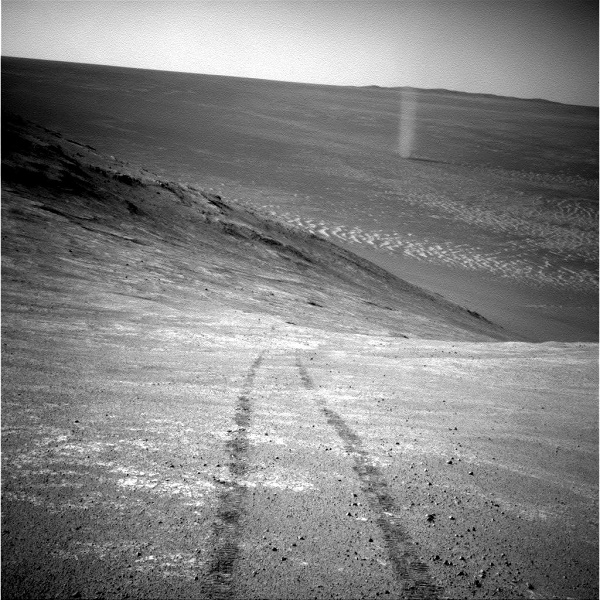By Ana Verayo, | April 04, 2016

A dust devil on the Meridini Planum region on Mars, captured by NASA's Opportunity rover.
NASA's Mars Opportunity rover captured a bizarre dust devil on the surface of the Red Planet, where the rover has been busy trekking and exploring the planet's terrain. This Martian event offers a glimpse of the potential dangers that can face future human colonizers on Mars.
Like Us on Facebook
The dust devil was spotted around the Meridiani Planum region which is where the lander completed its touchdown on the Red Planet in 2004. The sturdy rover is still traversing Mars despite its harsh, alien environment, surviving more than 4,300 Martian days. According to NASA Opportunity's deputy principal investigator, Ray Arvidson, this is one of the best examples of dust devils that have been observed on the Meridiani Planum, we are very lucky to capture this phenomenon in a single image.
The image is not a rare event on Mars as this type of alien, violent winds often occur on the sandy, arid world. Last 2012, mission scientists were able to detect a dust devil measuring 12 miles high with the help of the NASA Mars Reconnaissance Orbiter that has been obtaining data from the Martian atmosphere from lower Martian orbit.
Scientists believe that the dust devils on Mars are brought about by the same meteorological processes as the ones on Earth. This happens when a small area on the ground gets heats up to a higher temperatures than the other surrounding areas. When this hot air rises, the colder, more dense air falls to the ground that creates a vertical convection current. The surrounding powerful horizontal winds can flip these systems, creating a dust devil.
On Mars, this phenomenon is more often observed on the Gusec Crater which is where the Spirit rover, Opportunity's twin rover, was exploring and observing the region. During summer months, dust devils are generated more often, as daytime temperatures can peak up to 68 degrees Fahrenheit where some of the most massive dust devils can even reach up to 10 times bigger than the tornadoes of North America.
This ruddy, red dust can be swirled around, carried by winds travelling up to 70 miles per hour that can be dangerous to future space explorers on Mars. According to Mark T. Lemmon of the Department of Atmospheric Sciences from the Texas A & M University, the most hazardous part of these Martian dust devils is the sand on its lowest part. Even if the atmospheric pressure on Mars is only one percent on Earth at sea level, there would not be any wind felt against you however, you can be pierced by this high speed material.
Apart from this, this dust that is violently travelling and spiralling into the atmosphere can also become electrically charged, which can cause technical malfunctions, resulting in disastrous missions on spacecraft and human space habitats.
-
Use of Coronavirus Pandemic Drones Raises Privacy Concerns: Drones Spread Fear, Local Officials Say

-
Coronavirus Hampers The Delivery Of Lockheed Martin F-35 Stealth Fighters For 2020

-
Instagram Speeds Up Plans to Add Account Memorialization Feature Due to COVID-19 Deaths

-
NASA: Perseverance Plans to Bring 'Mars Rock' to Earth in 2031

-
600 Dead And 3,000 In The Hospital as Iranians Believed Drinking High-Concentrations of Alcohol Can Cure The Coronavirus

-
600 Dead And 3,000 In The Hospital as Iranians Believed Drinking High-Concentrations of Alcohol Can Cure The Coronavirus

-
COVID-19: Doctors, Nurses Use Virtual Reality to Learn New Skills in Treating Coronavirus Patients







